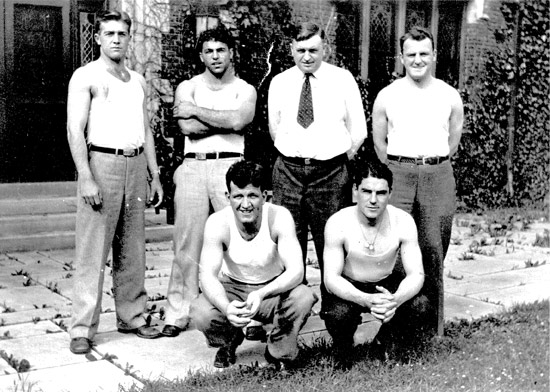-
Veronica O'Shea, Wife of a Chicago Asbestos
Worker, Mesothelioma
Veronica O'Shea contracted mesothelioma, a
cancer whose only known cause is exposure to
asbestos. Her husband Ed was a Local 17,
Chicago, Asbestos Worker.
She had significant exposure to asbestos from
washing her husband's work clothes that were
covered with white asbestos dust. Little did she
know that asbestos stayed in the house to get
"re-entrained" in the air. So just living in the house
of an asbestos worker exposed her to a toxic level
of asbestos dust.
Veronica and her family gave permission to have an
autopsy so that her lung tissue could be examined to
advance science with respect to household exposures.
The results of asbestos fiber analysis were staggering:
By light microscope, 7,480 asbestos bodies (coated
asbestos fibers) were found in Veronica's lung tissue.
A normal range for a city dweller would be 0-20
asbestos bodies per gram. By Scanning Electron
Microscope, an additional 24,900 coated asbestos
fibers and 40,000 uncoated asbestos fibers were found.
The tissue asbestos content in Veronica O'Shea's
case was equivalent to a heavy occupational
exposure to asbestos.
-
1972 Pittsburgh Corning Brochure
This photograph was taken from a
1972 Pittsburgh Corning brochure and
shows two Asbestos Workers applying
Unibestos around a 15-inch main steam pipe
in a powerhouse. The caption below the
picture states that Unibestos was specified
to be used for 12 miles of high-temperature
pipes in the plant.
The Pittsburgh Corning brochure shows
workers without any mask or respirator as
the approved way of working with their
asbestos products. Each piece would have
to be cut and fabricated, with the inside
of the insulation gouged out by hand tools
so that they would fit over welds on the pipe
made by the Pipefitters. Note that the
worker's shoes and the board beneath the
insulated pipe are covered with visible
asbestos dust. Unsuspecting workers
received toxic levels of asbestos exposure
that were often invisible to the naked eye.
-
1972 Unibestos Brochure Cover:
no mask or respirator shown
This photograph is from the front cover
of a 1972 Pittsburgh Corning product
brochure for Unibestos. Note that the
worker is applying asbestos without any
mask or respirator. The photograph shows
how workers would have to individually
cut or "miter" around pipe bends, creating
toxic levels of asbestos exposure from the
ensuing dust.
Asbestos Manufacturers from the 1930s
through the 1970s continually reinforced
through literature and photographs that
their products were safe, even though their
medical teams knew that asbestos was
deadly.
-
Trial Exhibit:
Asbestos Fibers Found in
Lung Cancer Tissue
This trial exhibit was used in the case of
Jim Stewart, a Chicago Asbestos Worker
who developed asbestos-induced lung
cancer. This is a photograph of Jim's actual
lung tissue taken from a light microscope.
You can see the "Ferruginous Bodies,"
which are coated asbestos fibers that were
found throughout Jim's lungs. These coated
asbestos fibers are in close proximity to
the cancer cells and are in close proximity
to the fibrosis or scarring in his lungs from
asbestos exposure. This scarring or fibrosis
of the inside of the lung is called
"asbestosis."
This photograph conclusively proved
that the lung cancer was caused by Jim's
occupational exposure to asbestos.
-
Commonwealth Edison Bulletin:
Will County Power Plant
Everything white in this photograph is
asbestos. The arrows point to open boxes
of asbestos pipe-covering.
Tons of asbestos cover the steam
pipes connecting the high- and low-pressure
turbines at this Commonwealth Edison
powerhouse in Chicago.
In total, more than 100 boxcars of asbestos
insulation would go into each unit of a
Commonwealth Edison powerhouse. Dust
would contaminate every section of the site
and would expose unsuspecting workers
working on mechanical equipment such
as turbines, valves, heat exchangers, boilers
and pumps.
-
Trial Exhibit:
116,000 Asbestos Bodies
Per Gram Of Lung Tissue
This Chicago Asbestos Worker's lung
tissue contained 116,000 asbestos bodies
(coated asbestos fibers) per gram in his
right lower lobe. A gram of lung tissue is
small, about the size of a sewing thimble.
A normal range for an urban dweller in
the U.S. would be in the range of 0 to
20 asbestos bodies per gram.
This trial exhibit was used to show the
magnitude of this insulator's exposure
to asbestos, which caused his lung cancer.
-
Hugh E. Mulligan's Summer Interns - 1929
Hugh Mulligan was head of the
Chicago Asbestos Workers Union from the
1920s to the 1970s. He was a contemporary
of Knute Rockne, Notre Dame's legendary
football coach. During the heart of the
Depression, and later, he would give
summer construction jobs to Rockne's
gridders.
Pictured here at a Mayslake retreat during
the summer of 1929 are five of Mulligan's
"Summer Interns."
Pictured (left to right) are: Back Row,
Larry "Moon" Mullins, Joe Savoldi, Hugh
Mulligan, Jack Cannon. Front Row, Glenn
"Judge" Carberry, Marchy Schwartz.
Four months later, these players went on
to win the 1929 National Championship of
College Football.
-
Owens Corning Asbestos Brochure
This photograph was taken from a 1956
Owens Corning "Kaylo" product brochure
and shows two insulators covering a large
steam pipe with asbestos pipe covering.
Although industry officials knew that
asbestos could cause asbestosis and lung
cancer, the brochure said that this product
was "non-irritating, non-toxic" and that it
"contribute[s] to worker well being."
The workers pictured in the brochure have
no mask or respirator - - reinforcing visually
that these products were "safe" to work
with. Note the asbestos dust covering their
hats.









